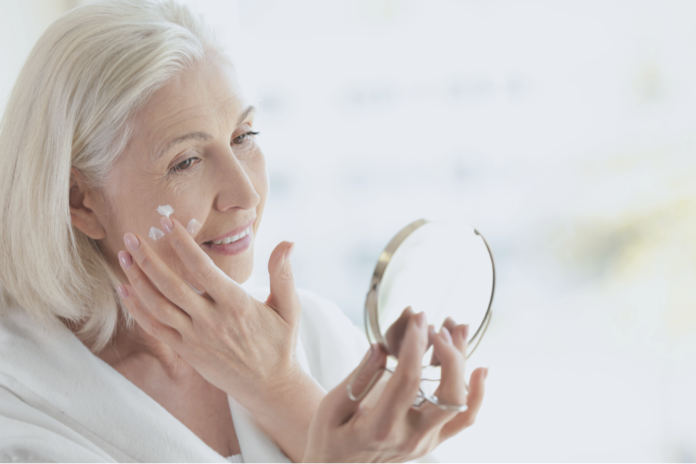Did you know that skin is considered an organ? In fact, it is the largest organ in or rather, on the human body.
The skin exerts many functions from acting as a barrier to preventing loss of moisture to reducing the harmful effects of UV radiation. It also helps regulate temperature, provides immunity, produces vitamin D and acts as a sensory organ.
Responsible for so many duties, it is even more important to treat and take care of it properly. Though skin care is important from an early age, it becomes even more important later in life.
Read on to learn all about skin care for seniors, including how to manage age spots and brown spots on skin, the best moisturizer for aging skin, and more.
Why Does Skin Degrade with Age?
The skin contains three main layers, including the epidermis, dermis, and subcutaneous layers:
- The epidermis is the outermost layer that is continually regenerated and includes keratinocyte, corneocyte, and melanocyte cells.
- The inner layer called the dermis includes the sweat glands, hair follicles, and subcutaneous glands.
- The subcutaneous layer consists of connective tissue and fat.
Now, despite the most potent skin care products in the world, skin aging is inevitable to some degree. There are certainly ways to mitigate skin damage as one ages, but some degradation is inevitable.
In fact, after the age of 20, the dermis layer of skin produces one percent less of collagen each year. Additionally, collagen and elastin fibers become thinker and looser, resulting in less elasticity and more brittle skin. This eventually results in the notorious wrinkling and sagging of the skin.
Furthermore, during people’s 20s, the skin’s innate exfoliation process decreases by 28 percent, which causes dead skin cells to accumulate and stick together. Then, in one’s 30s, the transfer of water from the dermis to the epidermis slows and fat cells shrink, leading to dull and thin-looking skin.
After the age of 40, collagen is no longer produced, causing fibers to break, thicken, stiffen, clump and lose elasticity and resulting in wrinkling and aging lines. If that is not enough, by 50 the skin becomes dry and is easily bruised, damaged, or broken because the oil glands decrease in size.
However, the above only includes the intrinsic causes of aging, and unfortunately, many extrinsic causes exist as well.
Thankfully, extrinsic causes are controllable to some extent, because they are generally a result of environmental damage and free radical production. This extrinsic aging appears as thickening of the epidermis and can lead to precancerous changes, skin cancer, age and dark spots, formation of freckles, and substantial losses of collagen, elastin, and glycosaminoglycans. The biggest environmental influences that cause the most free radical production include pollution, smoking, and UV radiation.
Still, gravity, facial movements, and sleep position are secondary factors that can contribute to undesirable changes in skin.
In summary, genetic mechanisms largely control the skin aging process, but environmental and lifestyle factors further influence the degree of skin degradation.
Typical Senior Skin Struggles
From wrinkles to age spots, seniors typically struggle with the skin issues detailed below.
Wrinkles & Sagging
The formation of wrinkles is largely dependent on the sun. The ultraviolet (UV) light emitted from the sun can damage elastin fibers, which are responsible for making skin appear plump and lifted. When damaged, these elastin fibers break and cause wrinkles and sagging.
Dark/Age Spots
These flat, brown spots are also usually a result of too much unprotected sun exposure. They are bigger than freckles and commonly appear on areas like the face, hands, arms, back and feet.
Dry & Itchy Skin
The main culprits of this skin issue include the natural decrease in skin hydration and inadequate consumption of hydrating fluids. Besides the face, dry spots most often appear on elbows, lower legs, and forearms. As skin loses or does not receive moisture, it naturally begins to feel rough and scaly, which can lead to itching.
Avoid overusing soap, antiperspirants and perfumes, apply moisturizer after showers, drink plenty of plain water and utilize heavier moisturizers in colder months to prevent this.
Bruising
The natural aging process causes collagen production to slow, so the skin becomes and looks thinner. Thus, the inner layers of the skin become more susceptible to bruising because there is not as much outer protection from the epidermis.
Skin Cancer
Much worse than causing wrinkles, too much UV exposure is the leading cause of skin cancer. Though anyone is susceptible, people with fair and freckled skin are most so. Of note, sunlamps and tanning beds can also cause skin cancer.
Main types of skin cancer, including basal cell carcinoma and squamous cell carcinoma, grow slowly and rarely cause metastasis and melanoma that is rarer but can spread to other organs and lead to death.
The first two kinds of skin cancers are typically found on parts of the body most exposed to sun like the head, face, neck, hands and arms, where melanoma can be found anywhere.
Best Senior Skin Care Tips
Aging might be inevitable, but one can take steps to reduce or prevent the aforementioned skin issues.
Apply Sunscreen
Because excessive unprotected skin exposure is the leading cause of skin damage, it is important to protect it, and besides staying out of the sun, applying sunscreen is the next best action.
Use SPF above 30 every day and reapply multiple times throughout the day when exposed to sun for long periods of time, such as at the beach. Research shows that sunscreen essentially gives the skin a break, providing its own powerful regenerative abilities an opportunity to revitalize.
Wash with a Gentle Cleaner
Many typical cleansers have high pH levels that are too harsh for most skin, leaving it more vulnerable to irritation and infection. Sodium lauryl sulfate and parabens are two ingredients to avoid most.
Conversely, gentle cleansers have low pH levels and fewer preservatives and ingredients in general. Using a gentle cleanser to remove makeup, natural skin oils, pollutants, and bacteria helps preserve the skin barrier and keeps it resistant to dehydration and damage.
Use an Exfoliant
As mentioned, skin preservation functions slow. Thus, skin replenishment slows and dead skin cells are not replaced by new, better cells as quickly. This further leads to dull, uneven, and cracking skin.
Exfoliants work by removing those dead skin cells to speed natural cell rejuvenation. They can be physical, such as sugar scrubs and bead cleansers or chemical peels, which gradually dissolve bonds between skin cells to spur cell regeneration.
Moisturize & Moisturize More
Do this not only with typical creams, serums and tinctures, but through adequate hydration as well. Inadequate hydration is one of the major reasons for fine lines, largely because of less sebum production, though, this also equates to less acne.
In terms of specific moisturizers, look for ones that contain water-binding humectants such as glycerine and hyaluronic acid. Furthermore, occlusives like petroleum and mineral oil help prevent hydration from escaping the skin at night.
Protect Skin from Trauma
Because older skin is more fragile, trauma to the skin can have larger impacts. Reduce skin trauma by sleeping on your back and avoiding strong rubbing or tugging motions when washing and applying skin care products to the face.
Quit Smoking
After sun (UV) exposure, smoking is the next leading environmental lifestyle factor that contributes to wrinkling the skin. Not only do the actual chemicals contained in tobacco damage skin cells, the mechanical motion of inhaling smoking devices also causes wrinkles.
Smoking is, of course, also implicated in heightening risk for much worse conditions like heart disease, stroke and cancer.
Top 10 Senior Skin Care Products
Rather than provide specific brands, this simple list contains the type or category of product to seek. There are more than thirty different brands for each of the following kinds of products at various price points.
Some are typical products; others are cruelty-free and non-toxic; and still, others are medical grade. Typing in something like “best moisturizer for aging skin over 60” is a simple way to search for the exact product you are looking for.
The following skin care product categories are included because they help reduce, prevent and/or reverse the most common senior skin care problems. The active ingredients in these types of products tend to be an extract like blueberry, an acid like hyaluronic acid, or an antioxidant like vitamin E among others.
- A.G.E. Interrupter
- Retinol Correxion Deep Wrinkle Serum
- Advanced Night Repair Cream
- Alastin Eye Cream
- TNS Recovery Complex
- Daily Moisturizer for specific skin type
- Vitamin C & E Product
- Vibransea Complex Serum
- Regeneration Serum
- Effective Sunscreen (above 30 SPF)
The Takeaway
As an organ, skin exerts many important functions as protection and insulation. And because it is so exposed to toxic danger like pollutants and radiation (and countertops!), it is important to care for it well.
Although some skin damage is related to natural aging processes, it is largely influenced by environmental lifestyle factors like using sunscreen and avoiding smoking.
Using targeted and individualized skin care products will best prevent and treat the skin care concerns associated with older adults. Additionally, wearing sunscreen and staying adequately hydrating appear to be two other very important measures!
References:
The Importance of Skin Care for the Elderly. Complete Care At Home. www.completecareatlanta.com/the-importance-of-skin-care-for-the-elderly.
Jaliman D. The Effects of Aging on Skin: Dry Skin, Loose Skin, and More. WebMD. www.webmd.com/beauty/cosmetic-procedures-aging-skin#1.
Robin M. 12 Derm-Approved Creams and Serums for Mature Skin. Allure. Published August 10, 2020. www.allure.com/gallery/best-creams-serums-mature-skin-dermatologist-recommendations.
Skin Care and Aging. National Institute on Aging. U.S. Department of Health and Human Services. Published October 1, 2017. www.nia.nih.gov/health/skin-care-and-aging.
Structure and Functions of the Skin. HSE. www.hse.gov.uk/skin/professional/causes/structure.htm.
Why Does Your Skin Age? Dartmouth Undergraduate Journal of Science. Published January 28, 2013. sites.dartmouth.edu/dujs/2013/01/28/why-does-your-skin-age/.
Wong M. 6 Step Anti-Aging Beauty Routine for Youthful Skin. Updated March 8, 2019. www.healthline.com/health/beauty-skin-care/anti-aging-routine-skincare.






